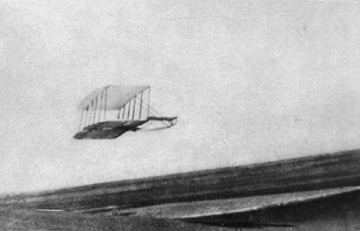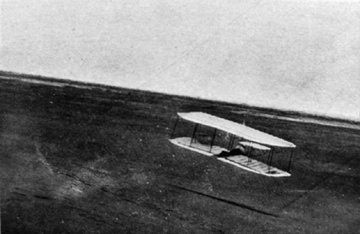

The Wright brothers returned to North Carolina in July, 1901. They made their camp in Kill Devil Hills, rather than Kitty Hawk, as they found the large hills there more congenial to flight tests than the beaches of Kitty Hawk. The glider was an enlarged version of the 1900 glider. The wings were 22' wide and 7' deep, and offered more than 300 square feet of lifting surface to the stiff Outer Bank winds.
Click on grid for 5" wide picture
Unfortunately, the 1901 glider still did not have adequate lift. Various attempts at free flight were made, the longest flight on August 8 covered a distance of 389 feet. The Wrights often tested their glider as a kite, in an effort to better understand how much lift the craft produced. It was clear that some error had crept into the formula they used to compute lift. The Wrights suspected the measurements of lift made by Lilienthal, although they also were aware that the Coefficient of Lift ("Smeaton's coefficient") could be wrong.

A high glide (photo Octave Chanute)
Still, the results of 1901 were discouraging. Wilbur wrote:
" When we left Kitty Hawk at the end of 1901, we doubted that we would
ever resume our experiments. Although we had broken the record for distance
in gliding, and although Mr. Chanute, who was present at that time, assured us
that our results were better than had ever before been attained, yet when we
looked at the time and money which we had expended, and considered the progress
made and the distance yet to go, we considered our experiments a failure. At
this time I made the prediction that men would sometime fly, but that it would
not be within our lifetime."
Phrases, like fish that get away, have an odd habit of growing larger over time. Orville later remember that Wilbur had remarked " Not within a thousand years would man ever fly!" Fortunately the two brothers proved Wilbur wrong the very next year.

The 1901 glider flies low over the ground (photo Octave Chanute)